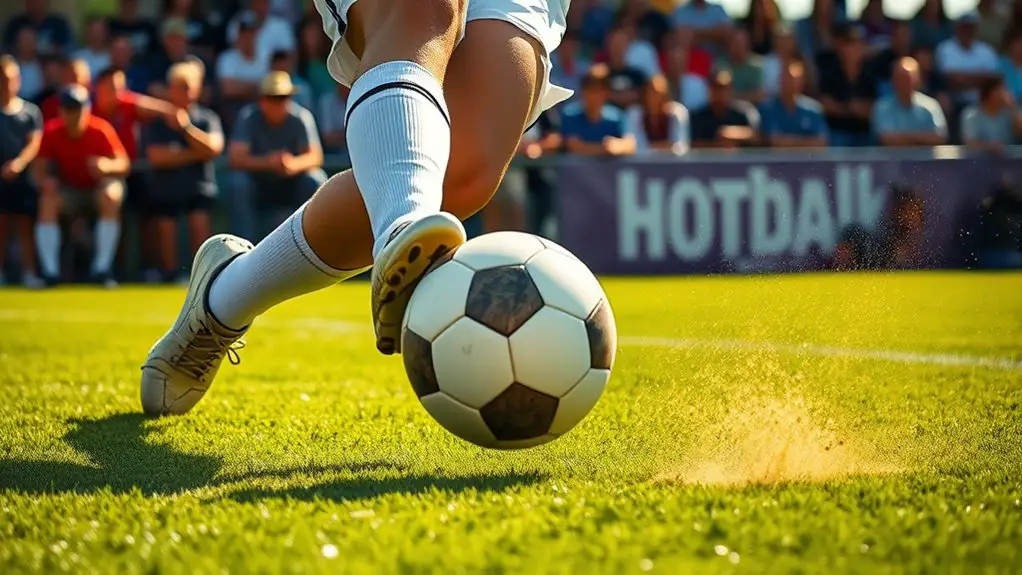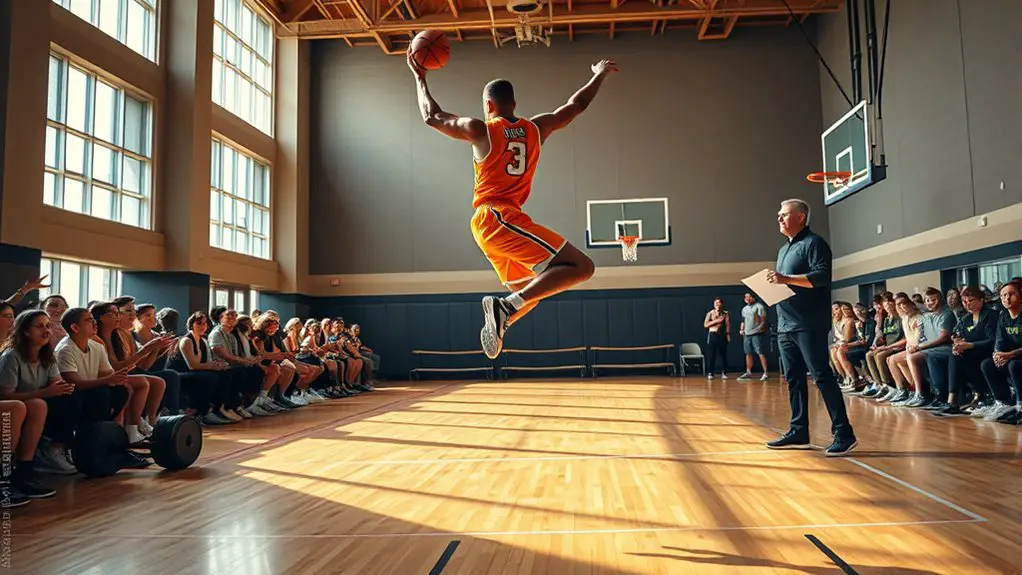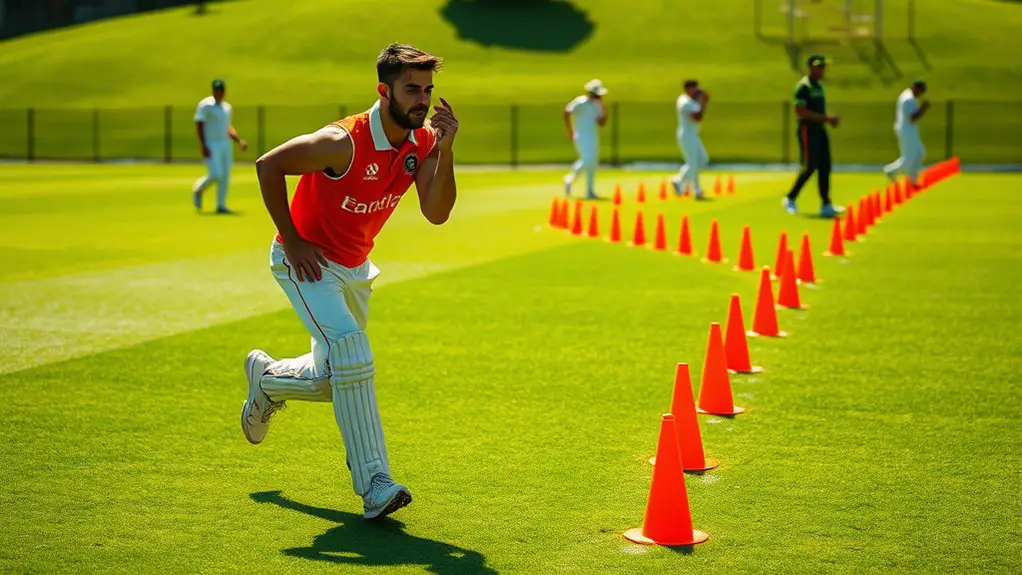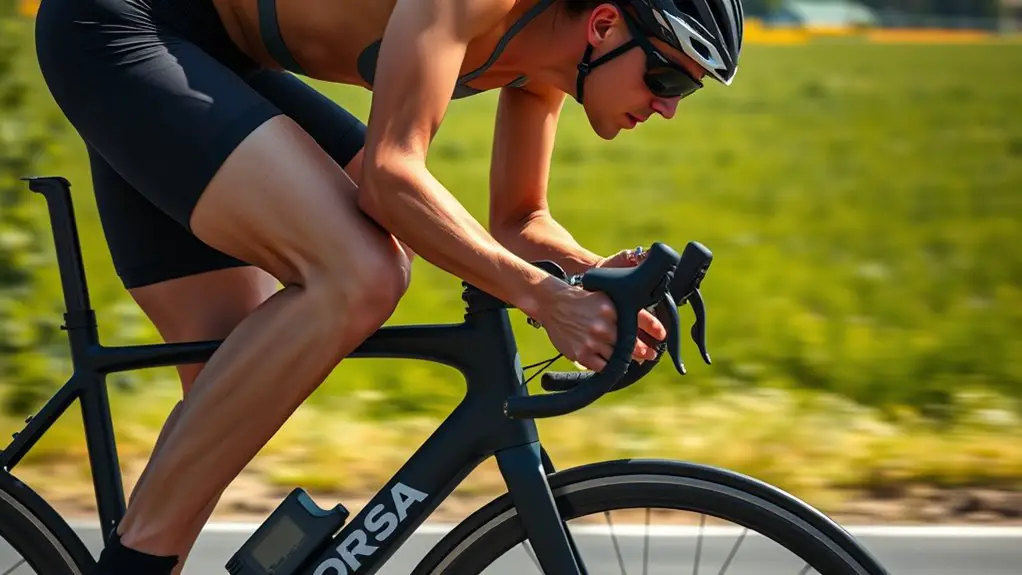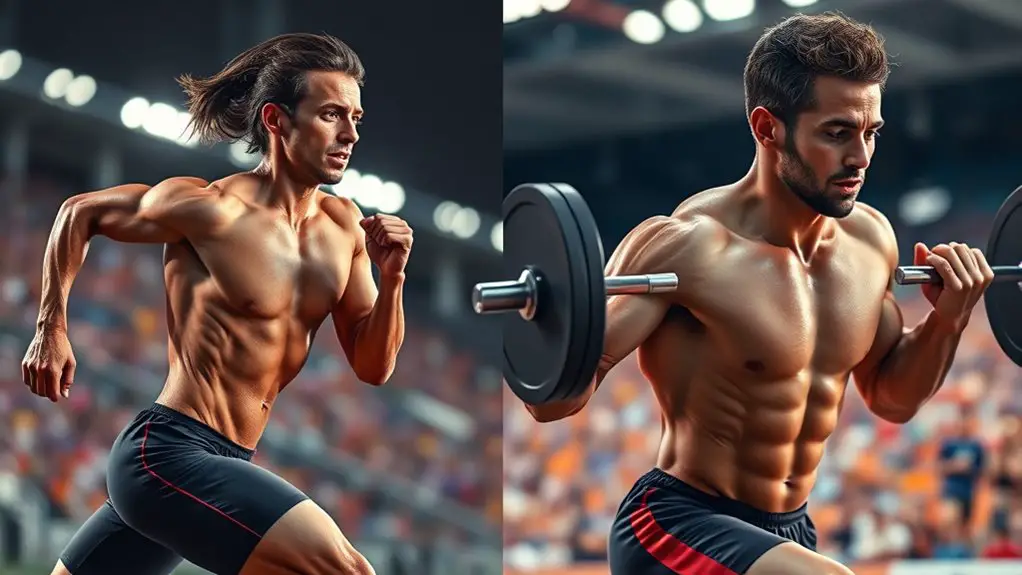To fine-tune your kick for greater propulsion, focus on kick efficiency and technique. Analyze your kicking form, increasing kick height and flexing your feet for better lift. Strengthen your core to enhance stability while kicking, and improve your ankle flexibility through stretches. Practice various kick drills to refine your technique, and monitor your kick frequency for ideal rhythm. Don't forget to maintain endurance with steady movements and proper hydration. There's more to discover that can elevate your performance.
Understanding the Importance of a Strong Kick
When you think about swimming, it's easy to overlook the kick, but a strong kick can make all the difference in your performance. It's your secret weapon, providing essential kick propulsion that propels you through the water with finesse. Imagine gliding effortlessly, feeling the freedom of movement as your legs drive you forward.
Kick efficiency is key; it's not just about how hard you kick but how effectively you use that energy. A well-timed, powerful kick can help maintain your body's balance and streamline your position, reducing drag. This means less energy wasted and more speed gained.
Analyzing Your Current Kicking Technique
A strong kick is only as effective as your technique allows it to be. To truly reveal your potential, you need to conduct a kick analysis, identifying areas that may be holding you back. It's about freedom—finding the power and efficiency in each movement. Additionally, understanding the role of strength training can significantly enhance your kicking performance.
| Aspect | Current Technique | Technique Adjustments |
|---|---|---|
| Kick Height | Too low | Aim higher for propulsion |
| Foot Position | Pointed down | Flex foot for better lift |
| Timing | Out of sync | Synchronize movements |
Strengthening Your Core for Better Stability
Although you may not realize it, a strong core is essential for achieving better stability in your kicks. When you kick, your entire body needs to work in harmony, and a solid core acts as the foundation. By incorporating core exercises into your routine, you can enhance your balance and control, allowing for more powerful and precise kicks. Core strength also helps to prevent injuries by stabilizing the spine and pelvis, reducing strain during high-impact movements.
Stability training focuses on strengthening the muscles around your abdomen and lower back, which helps maintain a strong posture during kicks. Simple exercises like planks, Russian twists, and leg raises can greatly improve your core strength. As you build your core, you'll find that your kicks become more fluid and confident, giving you the freedom to express your style.
The Role of Ankle Flexibility in Kicking
Ankle flexibility plays an essential role in your kicking technique, impacting both power and accuracy. If your ankles are tight, you might find it harder to achieve ideal position and follow-through. Fortunately, there are specific exercises you can incorporate to improve this mobility and enhance your kicks. Improved range of motion enhances your ability to execute techniques with ease, leading to more effective kicks.
Importance of Ankle Mobility
When you kick, the flexibility of your ankles plays an essential role in achieving power and accuracy. If you want to release your full potential, focusing on ankle mobility is key. Think about it: a more flexible ankle allows for a smoother, more explosive kick. You'll find your range of motion increases, leading to better control and precision. Incorporating ankle exercises and mobility drills into your routine can make a world of difference. Simple movements, like ankle circles or calf stretches, can enhance your flexibility and strength. By prioritizing ankle mobility, you're not just improving your kick; you're freeing yourself to express your athleticism fully. So, embrace these practices and watch your performance soar!
Exercises to Improve Flexibility
Improving your ankle flexibility is essential for enhancing your kicking technique. It'll give you that extra edge you're looking for. Start with dynamic stretching exercises like ankle circles and toe raises to warm up those joints. These movements improve blood flow and prepare your ankles for action. Incorporating yoga poses such as Downward Dog and Pigeon Pose can also work wonders. They stretch and strengthen your ankles while promoting overall flexibility. Remember, the more flexible your ankles are, the more power and precision you'll have in your kicks. So, embrace these exercises, feel the freedom in your movements, and watch as your kicking game reaches new heights. Flexibility is key—unlock your potential!
Practicing Different Kick Drills
To really enhance your kicking technique, practicing different kick drills is essential. You'll want to focus on the flutter kick, dolphin kick mechanics, and explore the benefits of the vertical kick. Each of these drills will help improve your overall performance in the water.
Flutter Kick Technique
Mastering the flutter kick technique is essential for enhancing your swimming performance and efficiency. To start, focus on your body position; keep it streamlined and relaxed, minimizing drag. Your hips should stay close to the surface while your legs extend behind you. Next, pay attention to kick timing. A steady, rhythmic motion is key—avoid kicking too hard or too fast. Instead, aim for small, quick kicks that generate propulsion without disrupting your balance. Incorporate drills like the vertical kick, which helps build strength and awareness of your kick. Also, practice with a kickboard to isolate your legs. As you refine your technique, you'll enjoy a more liberated swim, feeling the water propel you forward with ease.
Dolphin Kick Mechanics
While the dolphin kick may seem challenging at first, understanding its mechanics will greatly enhance your swimming technique. To master this powerful kick, focus on your body's undulation. Start by engaging your core, allowing your hips to drive the motion, while your legs follow in a fluid, rhythmic pattern. Practicing drills like the "kickboard dolphin" can help you isolate the movement and improve your kick propulsion. Remember, it's all about the wave-like motion—your legs should move together, not separately. Try experimenting with different kick tempos to discover what feels most natural for you. The more you practice, the more freedom you'll gain in the water, transforming your dolphin kick into a key asset in your swimming arsenal.
Vertical Kick Benefits
Building on the foundation of the dolphin kick, practicing vertical kicks can greatly enhance your overall swimming strength and technique. The vertical kick offers numerous advantages, like improved core stability and leg strength, which are essential for powerful propulsion. By incorporating specific vertical kick techniques into your training, you'll find that your endurance in the water increases considerably. These drills challenge your body in a unique way, forcing you to engage your muscles and develop a stronger kick. Plus, they can be done anywhere there's water, giving you the freedom to practice whenever you want. Embrace the benefits of vertical kicking, and watch how it transforms your swim performance, allowing you to glide effortlessly through the water.
Incorporating Fins to Enhance Your Kick
Many swimmers find that incorporating fins into their training can greatly enhance their kick. Fins can help you develop strength, improve technique, and gain speed, giving you that exhilarating sense of freedom in the water. With various fins types and fin materials available, you can choose what best suits your goals.
Here's a quick comparison to help you decide:
| Fin Type | Material | Benefits |
|---|---|---|
| Short Training Fins | Silicone | Increased propulsion |
| Long Blade Fins | Rubber | Enhanced kick technique |
| Swim Fins | Plastic | Versatile for all strokes |
| Monofin | Composite | Great for dolphin kicks |
Selecting the right fins can transform your workouts, allowing you to feel more powerful and agile in the water. Embrace the freedom fins offer and watch your kick flourish! Additionally, understanding aerobic capacity can further improve your swimming endurance and efficiency in the water.
Monitoring Your Kick Frequency and Rhythm
Fins can considerably enhance your kick training, but mastering the frequency and rhythm of your kick is just as important for overall performance. To achieve peak propulsion, you need to monitor your kick tempo closely. Pay attention to how quickly your legs are moving and verify that your tempo feels natural and fluid. Aim for rhythm synchronization between your arms and legs; this connection can propel you forward effortlessly.
Try experimenting with different tempos during your practice sessions. Feel how a faster kick tempo can energize your strokes, while a slower rhythm can help maintain control. It's all about finding the sweet spot that works for you. Use a metronome or music with a steady beat to help you stay in sync. By fine-tuning your kick frequency and rhythm, you'll not only enhance your performance but also enjoy the freedom of movement in the water.
Tips for Maintaining Endurance During Kicking
While it's easy to get caught up in the excitement of speed, maintaining endurance during kicking is essential for long-distance swimming. To boost your kick endurance, focus on a steady, rhythmic motion rather than frantic bursts of energy. Think about energy conservation; the smoother your kicks, the less fatigue you'll feel. Try to engage your core and hips, which can help distribute power more evenly and reduce strain on your legs.
Incorporate interval training into your routine. Alternate between high-intensity sprints and slower, controlled kicks to build stamina without burning out. Also, don't forget to breathe rhythmically. Proper breathing techniques can greatly impact your overall energy levels. Finally, listen to your body—if you're feeling fatigued, it's okay to adjust your pace. Embrace the freedom of swimming by finding a sustainable kick that keeps you moving efficiently for longer distances. Additionally, staying hydrated is crucial for maintaining performance and preventing fatigue during prolonged workouts; make sure to monitor urine color to assess your hydration status.
Frequently Asked Questions
What Are Common Mistakes Swimmers Make With Their Kicks?
Imagine gliding effortlessly through the water, but your kick's holding you back. Common mistakes swimmers make include poor kick timing; if your legs thrash like a wild river, you'll lose your rhythm. Also, lack of ankle flexibility can stiffen your movements, making you feel trapped. Embrace a relaxed kick, allowing your legs to flow freely, and remember, it's all about the harmony between timing and flexibility for that liberating swim experience.
How Can I Track My Kick Improvement Over Time?
To track your kick improvement over time, start by establishing clear kick tracking methods. Use a swim watch or app to monitor your lap times and stroke efficiency. Set specific improvement metrics, like reducing your time per lap or increasing distance per kick. Regularly review your data to spot trends and adjust your training. This way, you'll gain the freedom to swim faster and more efficiently, feeling the progress with every kick you take.
Is It Better to Kick With Straight Legs or Bent Knees?
When you're considering whether to kick with straight legs or bent knees, it often depends on your kicking mechanics and leg flexibility. Kicking with straight legs can enhance propulsion, but it might limit your range if you lack flexibility. On the other hand, bent knees allow for a more natural movement, promoting fluidity and freedom in your kick. Experiment with both styles to find what feels best for you and maximizes your performance.
Does My Body Position Affect My Kick Efficiency?
Yes, your body position definitely affects your kick efficiency. When your body alignment is ideal, it allows for better hip rotation, which can enhance your propulsion. If you're too rigid or misaligned, it can hinder the fluidity of your kick. So, focus on keeping your body relaxed and aligned, allowing your hips to rotate freely. This'll not only improve your efficiency but also give you a greater sense of freedom in your movements.
Can Nutrition Impact My Kicking Performance?
Nutrition can profoundly impact your kicking performance. When you focus on carbohydrate timing, you fuel your muscles for explosive energy. When you prioritize protein intake, you support muscle recovery and strength. Both elements work together to enhance your endurance and power, giving you the freedom to release your full potential. So, consider how your food choices can amplify your training and elevate your performance, allowing you to kick with confidence and precision.
